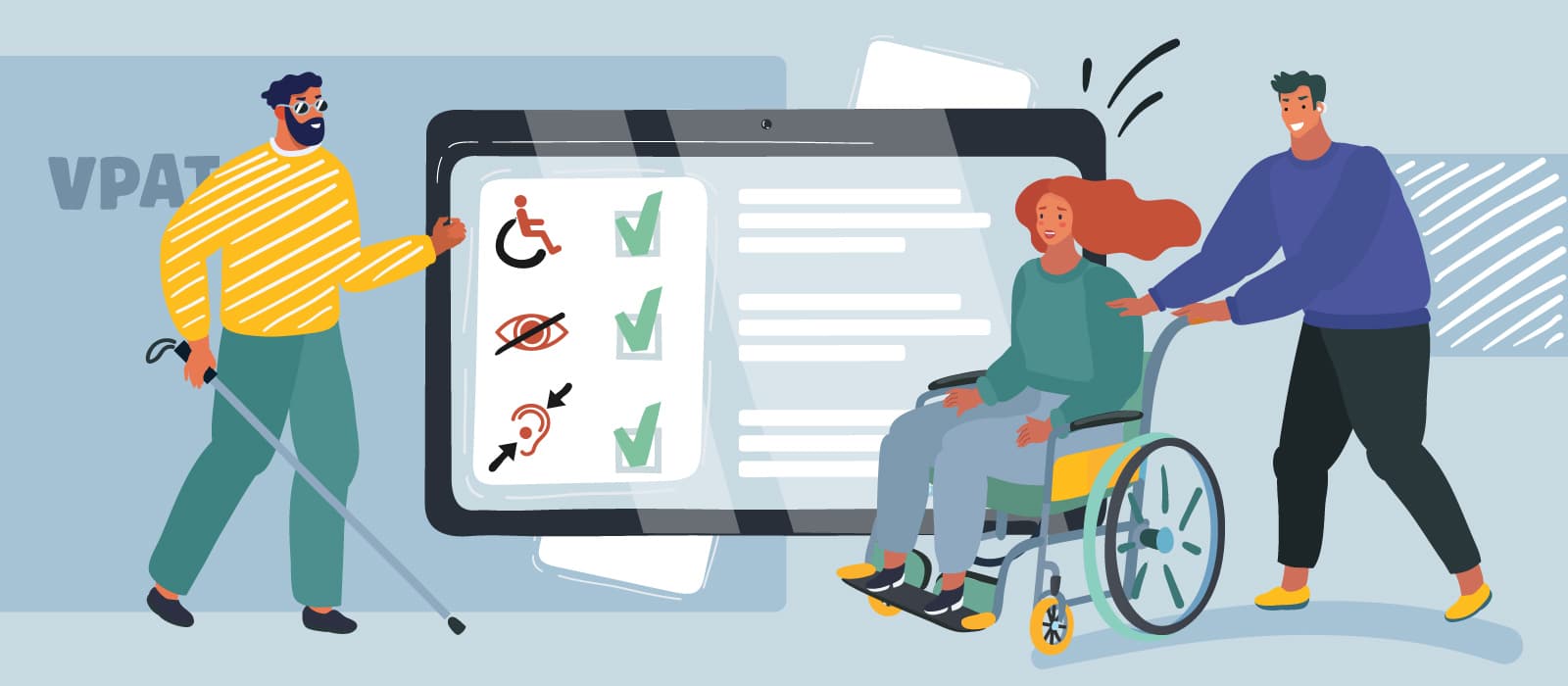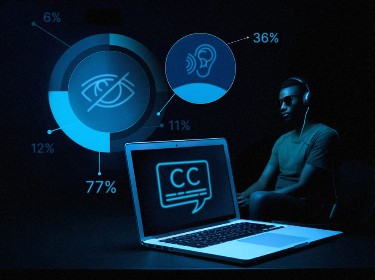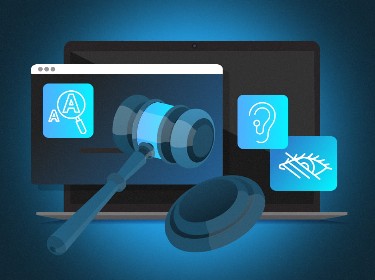To demonstrate transparency, companies report on their conformity to accessibility standards through a Voluntary Product Accessibility Template (VPAT). This template is then used by governments, non-government organisations and private institutions to evaluate the products and services offered in terms of their accessibility.
The UN Convention on the Rights of Persons with Disabilities recognizes access to information and communications technologies, including the Web, as a basic human right. Products and services around the world should be designed to work for all people, despite their technological capabilities, language, location, or ability.
The Web itself manages to erase barriers to communication and interaction that a lot of people encounter in the real world. Yet, if websites, applications, or some other tools are not designed properly, they can put up even bigger barriers. Thus, accessibility is essential for developers and organizations that want to make high-quality products or services, and not exclude people from them.
With this in mind, international and national standards have been created to define and provide tools for the regulation of accessibility levels of a product or a service. Product manufacturers and vendors use standardized templates to report how their products and services match the desired accessibility criteria, with the VPAT being just one of them.
Read on to find out more about the VPAT, what role it plays and why you need to use it.
What is a VPAT?
The Voluntary Product Accessibility Template (VPAT) is a standard template developed by the Information Technology Industry Council (ITI) and the U.S. General Services Administration (GSA). The template assists federal government contracting officials and other buyers in making preliminary assessments regarding the commercial availability of information and communications technology (ICT) products and services with features that support accessibility.
The VPAT also allows ICT product manufacturers and vendors to self-report on how their products meet accessibility standards, provide detailed information on implementation and testing performance, and describe any known defects. For businesses looking to ensure their solutions meet these standards, working with an accessible web development company can help streamline the process of making ICT products fully compliant with accessibility requirements.
The most recent versions of the VPAT incorporate international standards, including WCAG 2.0/2.1, the revised Section 508 standards, and the European standard EN 301 549.
There are four versions of the VPAT template: one for each of the standards mentioned above and one that includes all of the standards. The templates consist of tables with accessibility criteria that the product manufacturer or vendor fills in. In this way they can indicate if and how the features and functions of their product or service meet the technical and functional performance requirements of the applicable standards.
Why was the VPAT created?
![]()
Accessibility is all about social inclusion for people with disabilities as well as older people, those living in rural areas, and in developing countries. Accessibility also has to do with mobile web design, device independence, multi-modal interaction, usability, design for older users and search engine optimization (SEO). According to the World Wide Web Consortium, case studies show that accessible websites have better search results, reduced maintenance costs, and increased audience reach, among other benefits.
The VPAT was created to provide a way for companies to display their accessibility conformance findings, standard by standard. The VPAT helps government agencies evaluate the level of conformity of a product or service. It also enables companies to self-report their own compliance levels.
Section 508 of the Rehabilitation Act requires U.S. federal government agencies to ensure that any information and communications technology (ICT) they develop, procure, maintain, or use meets specific accessibility standards. In 2001, the Information Technology Industry Council (ITI) and the U.S. General Services Administration (GSA) created the VPAT that enables vendors to furnish that supporting documentation.
What does the VPAT include?
The VPAT was initially developed to support documentation of conformance with the technical and functional performance requirements of Section 508 of the Rehabilitation Act (as published in 1998). However, since that time, there have been numerous calls for ICT product manufacturers and vendors to document conformance with multiple ICT accessibility standards. To address this growing demand, ITI updated the VPAT to cover changes to Section 508 that were finalized and published in 2017. Known as the Revised 508 Standards, this update incorporates Web Content Accessibility Guidelines 2.x. The VPAT also includes the reports necessary to document European standard EN 301 549. To be more precise, the VPAT includes documentation of conformance to:
- Section 508 Refresh 2017 (Chapters 3, 4, 5, and 6)
- WCAG 2.0 Success Criteria & Conformance Requirements
- WCAG 2.1 Success Criteria & Conformance Requirements
- EN 301 549 (Chapters 4 — 13).
Rather than requiring documentation of conformance to all criteria from multiple standards or within one standard, the VPAT breaks down the criteria into sections that can easily be removed if they do not apply.
Section 508
Section 508 of the Rehabilitation Act of 1973 (amended in 1998) requires that when U.S. federal government agencies develop, procure, maintain, or use ICT technology, federal employees and members of the public with disabilities must have exactly the same access to and use of information as individuals without disabilities.
According to the regulation, the scope of Section 508 is limited to the federal sector. Nevertheless, many U.S. states and some local public sector organizations (such as government agencies and publicly funded educational institutions) have also adopted the Section 508 standards and require them in procurement.
The Revised 508 Standards comply with international standards including the Web Content Accessibility Guidelines 2.0 (WCAG 2.0), which are incorporated by reference. This means that WCAG 2.0 conformance requirements are used to measure the compliance of documents, web content, and software for Section 508. Besides, platform software, application software, and mobile apps must conform to the relevant software technical standards as well as WCAG 2.0 (W3C Guidance on Applying WCAG 2.0 to Non-Web ICT).
WCAG 2.x
The Web Content Accessibility Guidelines 2.0 (WCAG 2.0) and 2.1 (WCAG 2.1) were developed by the World Wide Web Consortium (W3C) Web Accessibility Initiative in cooperation with individuals and organizations around the world. WCAG 2.x provides a single shared standard for web content accessibility that meets the needs of individuals, organizations, and governments internationally.
WCAG 2.0 is the tracking standard for web accessibility for almost all entities worldwide, and most of the WCAG 2.1 criteria have been incorporated into EN 301 549. WCAG 2.x states that web content should be perceivable, operable, understandable, and robust. While WCAG 2.0 applies to web content, it has also been applied to mobile accessibility as well as to non-web ICT.
EN 301 549
Passed in 2014, EN 301 549 is a digital accessibility standard in the European Union (EU) created in response to a request by the European Commission. It was adopted as the default standard in 2016 in Directive 2016/2102/EU, which applies to public sector websites and mobile apps throughout the EU. As of January 2017, EN 301 549 became the standard for accessible procurement in Europe. The current version of EN 301 549 incorporates WCAG 2.1, and there is substantial harmonization between EN 301 549 and Revised 508 Standards.
Why do you need to complete a VPAT?
![]()
Given that the Americans with Disabilities Act (ADA) does not include explicit criteria on digital accessibility, there is ambiguity when attempting to differentiate accessible and inaccessible digital content.
Even though the Web Content Accessibility Guidelines (WCAG) are universally accepted as the de facto guidelines for digital accessibility, many of the criteria are not clearly stated. Physical ADA standards (such as the number of accessible parking spaces or elevators in a building) are far more precisely defined.
It comes as no surprise that organizations trying to present irrefutable proofs that their digital content is accessible are often bewildered by this lack of clarity. This kind of situation is where a VPAT can be useful to almost all organizations, even those not interested in conducting business with the federal government. A VPAT provides a clearly defined standard upon which any organization can measure its accessibility. Section 508 requirements map to WCAG, and because the VPAT itself is officially recognized, organizations that can show they conform to Section 508 requirements can present themselves more credibly as accessible.
Read this article to learn more about ADA approved fonts and their characteristics
How do I get a VPAT?
There are four different versions of the VPAT currently in use. The best place to get a VPAT is from the ITI website. The template can be filled in either by the company itself or by an external consulting firm employed to complete the process.
Companies that opt to create a VPAT internally must complete a Section 508 audit of the application in question. Training an internal team to create an accurate VPAT requires significant accessibility domain knowledge. If an internal team already exists, then the company must put in place accessibility auditing infrastructure to support the auditing. Such solutions should enable testing against all the Section 508/WCAG requirements including the technical ones and functional performance criteria as well as information, documentation, and support parameters in a single location.
If a company opts to get a VPAT completed by a consulting company, they must assure that they have enough data for the consulting company to carry out an audit. Each audit report detects all accessibility errors within the system and arranges them according to priority. It also comes up with the method for resolving the issues, and records the system’s overall compliance with Section 508, WCAG, or EN 301 549. The audits are then used to improve the compliance of the system and successfully create a VPAT.
Overview of technologies and formats
Designing web content and mobile applications for accessibility and a high level of conformity to standards such as Section 508, WCAG, and EN 301 549 involves different technologies and document formats. Designers have to consider the level of built-in accessibility support, the types of devices and platforms that support it, and the ways to make content accessible and maintainable.
Accessibility allows users to interact with web pages using assistive technologies such as software for screen reading, screen magnification, speech recognition, alternative input devices that mimic a standard keyboard, and refreshable braille displays that transform the content into braille.
Standards found throughout the VPAT specify how developers must integrate assistive technologies. These standards are not just for people with disabilities. They help define a common language for web technologies so that all our browsers, web pages, and web applications can work together. Different technologies and document formats offer various levels of accessibility for all users. For content that is primarily text and graphics based, common file formats such as HTML, PDF, and Office Documents are used.
HTML
HTML and its related technologies such as CSS offer the best flexibility when it comes to support on different devices and platforms, and support for people with disabilities. HTML format is viewable on a multitude of devices, and provides an easy way to create rich semantics to describe Web pages.
PDF files are so popular just because they enable an author to control the look and feel of a document, irrespective of the platform on which the end user will be viewing the content. Many PDF creation tools integrate with almost any application. However, PDF documents are difficult to make accessible. Only a few applications, such as Adobe Acrobat Professional tools, will make a PDF file accessible with no additional work.
Office Documents
Office documents vary depending on how much accessibility support they provide. Microsoft Office documents, for example, can be made quite accessible. There are certain techniques, including headings, for providing semantic structure to the pages and adding extra accessibility information like alternative textual descriptions when needed. Office documents have a disadvantage in that they frequently require a third-party application to view.
Since many PDF documents are initially office documents, it is sometimes easier to provide users with the original office document instead of a PDF version.
What does the vendor report?
![]()
If the vendor has a web-related product (web application, mobile application, or website), then they are required to fill out the WCAG 2.0 report and only Chapters 3 and 6 of the 2017 Section 508 Report. Other chapters are focused on electronic and information resources such as software, hardware, and non-web documents (PDF) that have additional functional requirements.
The vendor’s technical staff should be able to assist in the testing and reporting on the VPAT and be aware of the compliance standards that need to be added to the product’s roadmap as a high priority.
After completing the VPAT, the vendor should make it available on their website. This will reduce the time required for their customers to complete procurement processes. Considering that each product goes through versioning, the VPAT should be updated with any changes to accessibility compliance.
Conclusion
The VPAT is used as a tool to report the level of conformity to various accessibility standards. A completed VPAT is a company’s report on the accessibility of their product. An evaluating company, government, or non-government organization uses the VPAT to analyze each technical standard and evaluate the indicated products and services to see if the standard is fully supported, not supported, or not applicable.
VPATs manage to cover a wide range of products including computer software, imaging hardware and services. ITI provides guidance for completing VPATs but, surely, both manufacturers and suppliers hold responsibility for the clarity, integrity, and usefulness of the content contained in the report.
The official VPAT forms are hosted by the Information Technology Industry Council and are available in the Microsoft Word format. However, to ensure that you comply with all VPAT requirements, you should turn to a reliable web accessibility consulting company that will deal with all the details and provide the desired result.




